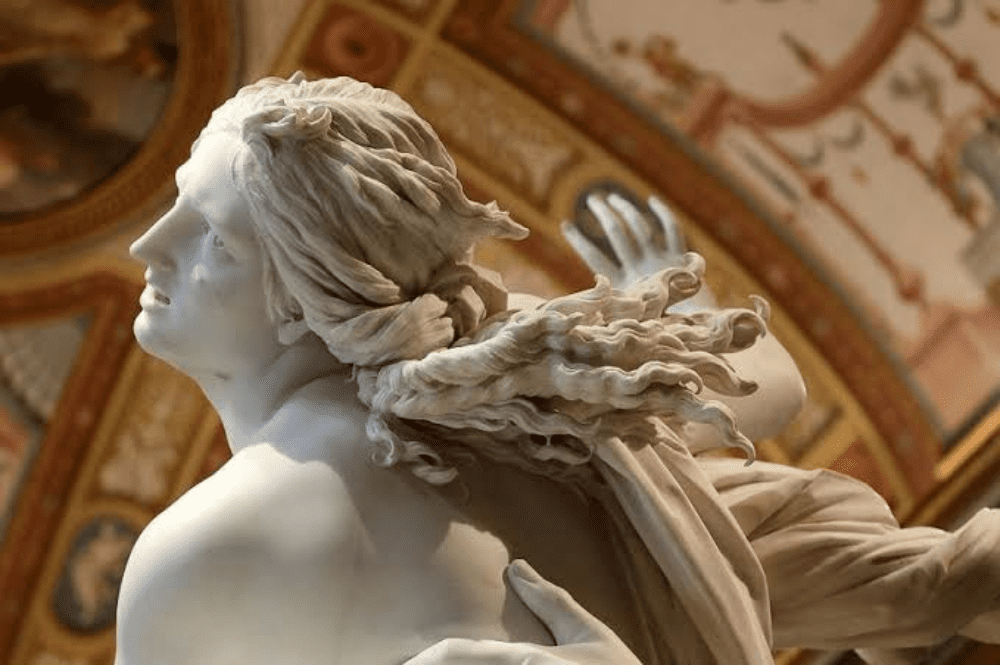Reading Time: 4 minutes
Monika explores Gian Lorenzo Bernini’s “The Abduction of Proserpina,” a captivating sculpture with timeless themes and masterful technique, exclusively for Different Truths.
Gian Lorenzo Bernini’s “The Rape of Proserpina” (more accurately translated as “The Abduction of Proserpina”) is a baroque ballet of passion, struggle, and the inevitable grip of fate.
It stands beautifully carved in the heart of Rome’s Borghese Gallery. More than just carved stone, it captures a timeless scene from myth.
Completed in 1622 when Bernini was a mere 23 years old, the sculpture freezes a moment from Roman mythology in a whirlwind of emotion and breathtaking artistry.
The scene depicts the abduction of Proserpina. the daughter of Ceres, the goddess of agriculture. Pluto, the god of the underworld emerges from the earth’s crust in awe of Proserpina’s beauty. his powerful hand firmly grasping her flailing form. Her struggle is palpable – her dress billows around her, her leg extended in a desperate attempt to resist. Yet, a closer look reveals a hint of something else amidst the terror. a sliver of resignation, a dawning awareness of the futility of her fight.
Bernini’s genius lies in his ability to capture the fleeting essence of movement within the permanence of stone. Proserpina’s torso twists in a desperate S-curve, conveying the dynamism of the abduction. Pluto’s muscular form, a study in anatomical precision, radiates an irresistible force. The interplay of light and shadow further accentuates the drama, drawing the viewer into the heart of the struggle.
But the true brilliance of the sculpture lies in its psychological complexity. Proserpina is not merely a passive victim. Her contorted face reflects a mix of emotions: fear, defiance, and a flicker of something akin to fascination in her upturned gaze towards Pluto. Pluto, for his part, is not a monstrous villain. His brow furrows in concentration, his lips pursed in determination. There’s a hint of tenderness in his grip, a suggestion of a reluctant abduction fueled by desire rather than cruelty.
The sculpture transcends the mythological narrative, becoming a commentary on the human condition. It captures the universal struggle between control and surrender, between fear and desire. Proserpina’s plight resonates with anyone who has ever felt powerless in the face of a stronger force, be it love, fate, or circumstance.
The inclusion of Cerberus, the three-headed guardian of the underworld, adds another layer of depth. He sits at Pluto’s feet, a silent observer to the drama unfolding. His presence foreshadows Proserpina’s descent into the underworld, a realm from which she will never truly escape.
“The Abduction of Proserpina” is a testament to Bernini’s mastery of both technique and storytelling. It is a sculpture that breathes, that moves, and that speaks volumes without uttering a word. It is a timeless masterpiece that continues to captivate and enthrall viewers centuries after its creation.
Revealing minute details, the precision in sculpting is what Bernini is renowned for. His ability to breathe life into cold marble through such meticulous attention to detail is a hallmark of his Baroque style. By capturing the texture of hair, the strain of muscles, and the imprint of touch, Bernini creates a sculpture that transcends the static form and pulsates with emotion and movement.
Bernini depicts Proserpina’s hair in a state of disarray, with individual strands escaping from her grasp. This detail emphasises the struggle and urgency of the moment, as Proserpina tries to break free from Pluto’s hold.
Pluto’s Beard: The beard on Pluto’s face is meticulously carved, with each strand textured to appear coarse and wild. This detail contrasts with Proserpina’s delicate features and reinforces Pluto’s image as a powerful and primal god.
The way Pluto’s hands grip Proserpina’s thigh is a particularly striking detail. Bernini’s masterful sculpting captures the tension in their muscles, conveying Pluto’s forceful grip and Proserpina’s desperate attempt to resist. The indentations of Pluto’s fingers on Proserpina’s flesh further heightens the drama and pathos of the scene.
Standing at over eight feet tall, the sculpture is crafted from a single block of Carrara marble, a testament to Bernini’s phenomenal skill. The meticulous attention to detail is staggering, from the delicate folds of Proserpina’s dress to the texture of Pluto’s beard. Bernini’s innovative use of chiaroscuro, the play of light and shadow further enhances the drama and imbues the figures with an almost lifelike quality.
This early masterpiece solidified Bernini’s reputation as a prodigy of sculpture. His ability to capture the essence of human emotion and movement in a cold, hard material set a new standard for Baroque art. “The Abduction of Proserpina” remains a cornerstone of Western art, a powerful reminder of the timeless allure of mythology and the enduring legacy of artistic genius.
Bernini was a remarkably quick sculptor. He is said to have completed “The Abduction of Proserpina” in a mere two years, an astonishing feat considering the complexity of the work. This virtuosity and speed added to his reputation as a prodigy and cemented his place as a leading sculptor of the Baroque era.
Bibliography:
Chiaroscuro: The dramatic play of light and shadow in art adds depth. heightens drama and creates a more emotional experience
Carrara marble: It’s a prized white or blue-grey marble known for its beauty and workability. Quarried for centuries in the mountains of Tuscany, In Italy, it’s been a favourite material of sculptors and architects for its fine grain and ability to take a high polish.
References:
https://en.wikipedia.org/wiki/The_Rape_of_Proserpina
Wittkower, Rudolf. Gian Lorenzo Bernini: The Sculptor of the Roman Baroque. London: Phaidon Press, 1955.
Baldinucci, Filippo. The Life of Bernini. University Park: Pennsylvania State University Press, 1971.
Photos were sourced by the reviewer.
